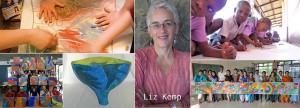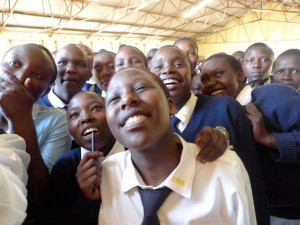Art and the Teacher’s Eye: Arts Skills Training Workshop for Teachers, Kenya.
On Tuesday the 8th of October I will be in Kericho, one of Kenya’s main tea plantation towns in the upper Rift Valley region, to meet up and make art with twenty secondary school teachers from four schools in the area. The teachers are taking part in a unique skills training and capacity building project that will help them to develop and use their natural artistic abilities to enrich their work as educational professionals and encourage them to explore new ways of introducing creativity to their classrooms.
The five-day workshop is funded by the Scottish-based charity, KABISA in Kenya and I have designed and will facilitate the training programme throughout the week. Kenyan Government schools do not include art as a curriculum subject at either primary or secondary level education, with the result that opportunities for interactive creative learning are overlooked and undervalued. There are several reasons for this but principally, it is due to the immense pressure schools are under to perform well in the annual government education league tables which value the presentation of learned “facts” above individual reflection and analysis and prioritises rote-learning above other contemporary methods of teaching.

LIZ IN ACTION WITH THE TEACHERS
So why are these teachers giving up five days to take part in a training event that is going to challenge them personally, question their teaching practices and make them play apparently silly games? What will they gain and most importantly, will they be enabled to use the skills of art to make positive changes in their classrooms and will their creative confidence improve as a result of five days of making art?
In short answer to why these teachers will turn up, it is because two teachers, Mary Nasieku, head teacher of St Mary’s Girls Secondary School, Nakuru and Nelson Rotich, head of English in Kericho Boys High School, Kericho Town, believe that the arts have a vital role to play in education and want to initiate more interdisciplinary and creative projects in their schools that will be generated by, with and for their respective communities.
I have worked in Kenya twice before with KABISA. In 2011 I presented a set of one-day Art Intervention Workshops with a total of seven schools and the following year (2012) I facilitated a second project, based in St Mary’s in Nakuru, that empowered 70 girls and a handful of teachers to create a large-scale mural for one of the school classrooms. From conception to design, all the way through to the final painting and highly polished finishing, the entire artwork was made by the girls, much to their delight and sense of achievement.
CHILDREN IN FRONT OF A BUTTERFLY MURAL
In support of the main project, I also ran a series of Creative Body sessions (theatre-based games and movement exercises) and basic visual art activities throughout the week to demonstrate the ease with which the arts can uplift a community and how artistic creativity can transform the ordinary into something truly memorable.
The response from both teachers and students was overwhelmingly positive and at the conclusion of the week, we all wanted to find ways to extend and develop this creative energy and purpose. It was quickly agreed that a TOT (Training of Teachers) approach would offer the most effective next step and in a new networking opportunity for both schools, St Mary’s Ms Nasieku joined forces with Kericho’s Mr Rotich to draw up a proposal for some form of creative arts training for selected teachers. KABISA was requested to provide support funding and I was then asked to formulate the Arts Skills Training Programme for Teachers and to facilitate the training. It is the first programme of its kind in Kenya and will benefit hugely from being a home-grown initiative, generated by teachers themselves and as a direct result of successful experiences with previous creative arts activities. What better basis could there be from which to move forward?
MINDFUL CREATIVITY
Answers to this and the other questions are of the “watch this space” variety and I hope to provide these on my return from Kenya.
It is exciting and a privilege to be the artist invited to facilitate the training workshop and I am looking forward to the various challenges ahead. Over the thirty-plus years of my experience as a socially engaged artist, I have seen many examples of how hands-on experience in the arts can transform lives and deliver positive outcomes that have lasting significance for communities and individuals. Training in the creative arts for non-arts professionals is constructive, powerful and life-affirming and has the capacity to open doors for people to find their unique voice and tap into their inner resources of imagination and invention.
Finally, it is important to mention that the week of the 8th to 12th October will be FUN. Working with the materials and activities of art is undeniably pleasurable (I would challenge anyone to open a new box of coloured chalk pastels and not want to scribble away madly) and I know that engagement with the workings of art brings many rewards to those who take part. I am already looking forward to next week’s creative adventures with my enthusiastic fellow travellers…taking part in art!
CHILDHOOD JOY
LIZ KEMP runs community-based visual arts projects in various countries: India, Pakistan, Kenya and her native Scotland. She lives in the picturesque village of Comrie in Perthshire. Liz can be found on www.lizkemp.co.uk






Leave a Reply